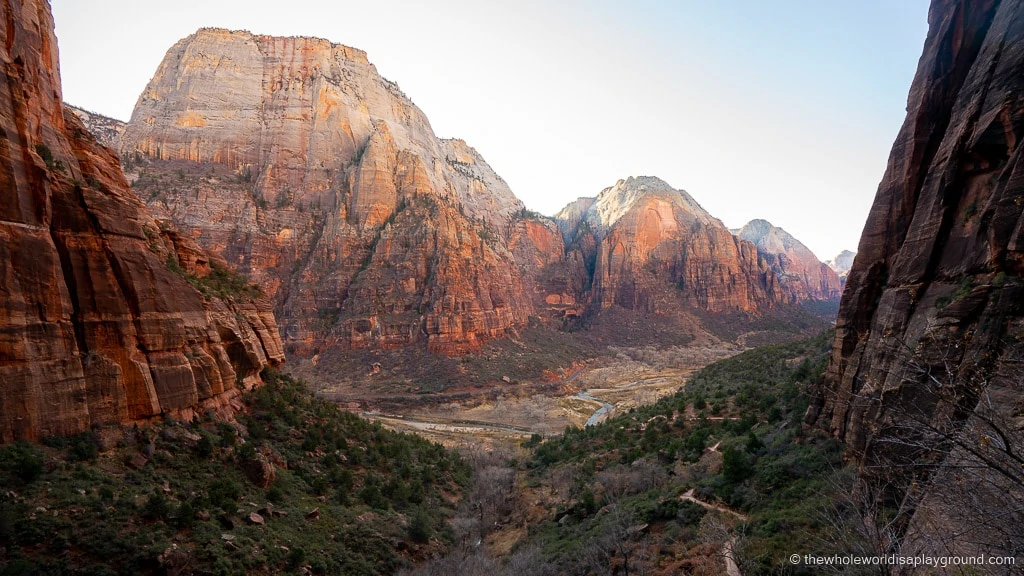This post may contain compensated links. Find more info in our disclosure policy.
With its magnificent soaring red cliffs, adrenaline inducing hikes and rich variety of wildlife Zion National Park is an amazing place to visit. For those of you planning a trip to Zion, we wanted to share our tips and guide for first time visitors to Zion National Park. We’ve included our recommendations on where to stay, how the shuttle bus works and a lowdown of the best hikes in Zion.
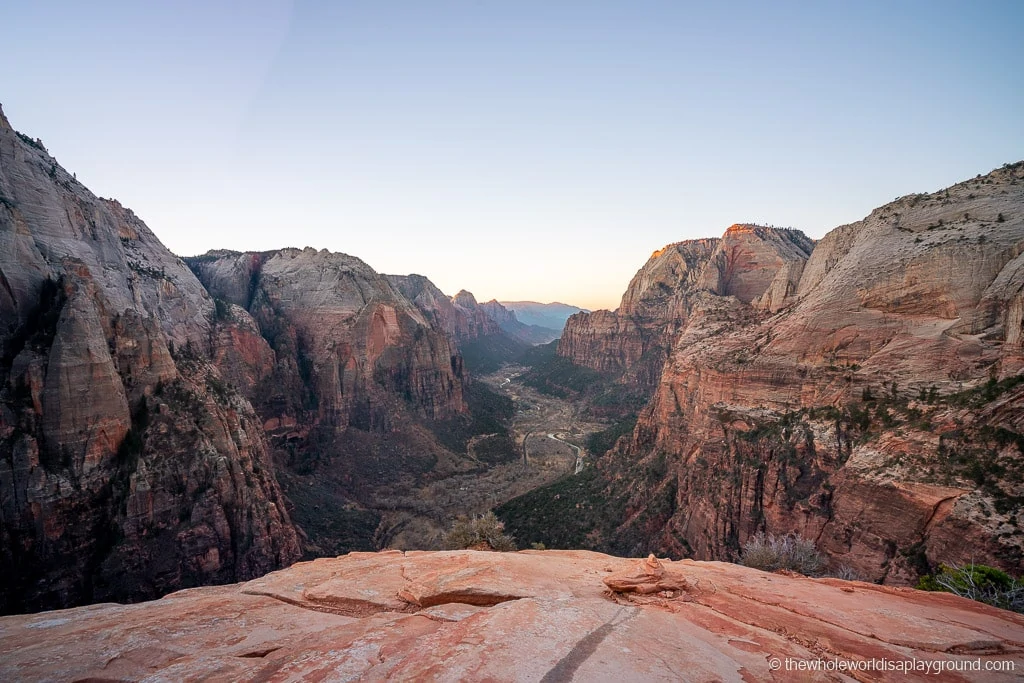
Zion National Park
Located beside the tiny town of Springdale in Utah, Zion is the 4th most popular National Park with over 4.5 million visitors in 2019. It is home of the tallest sandstone cliffs in the world.
In the main section of the park red and white cliffs soar over the Virgin River and the Zion Canyon valley floor. The finger canyons and red Navajo sandstone cut through the north west section of the park in the more remote Kolob Canyon section of the park.
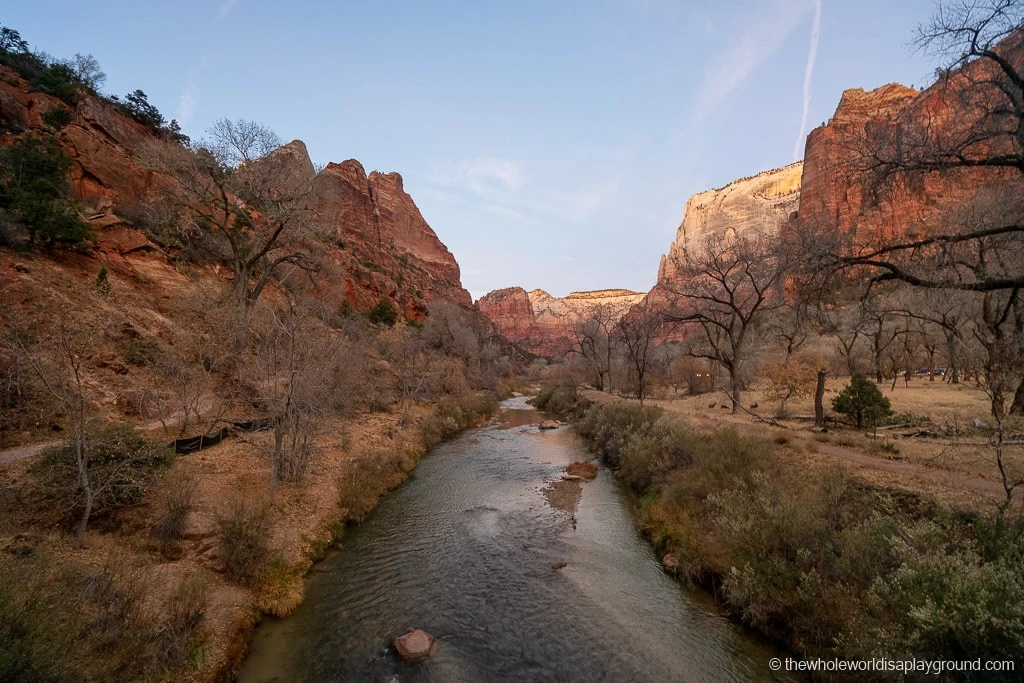
How to get to Zion
For international visitors, the closest major airport is McCarren International Airport in Las Vegas (170 miles) followed by Salt Lake City International Airport (313 miles).
Ultimate guide to Zion tip: We’ve flown into Las Vegas on previous visits and the Valley of Fire State Park is an awesome stop on route to Zion.
If you are flying, we recommend using RentalCars.com to reserve your car as they have the best selection and prices that we’ve found – click here to book now! We’re huge road trip fans and have rented cars in over 40 countries and we usually find the best deal on RentalCars.com.
Book your Zion rental car now with RentalCars.com
If you prefer not to rent a car, there are some great day trips from Las Vegas – check prices here!
Many visitors combine a visit to Zion with a trip to the nearby Bryce Canyon which is a 90-minute drive from Zion. If you have longer to explore, then a Utah road trip taking in the ‘Mighty 5’ Utah National Parks is an amazing option.
Ultimate guide to Zion tip: if you are visiting Zion as part of a bigger Utah National Parks Road Trip to the Mighty Five then check out our Utah National Parks Road Trip itinerary here.
Where to stay in Zion
- Camping: There are two campsites, Watchman Campground and South Campground, within the park. Both campsites are located near the visitors center at the South entrance. At the Watchman sites are released for reservation on a 6 month rolling basis while in the South Campground it is on a 14 day rolling basis.
- Zion Lodge: located deep within the park the historic lodge offers a mix of cabins and hotel rooms. We’ve stayed in the Lodge and it’s a nice traditional option which really allows you to immerse yourself in the park. The lodge fills up well in advance so it’s worth checking your dates well in advance of your trip. We highly recommend staying here as its an incredible location – check prices here!
Springdale
With limited accommodation in the park itself visitors to Zion typically stay in Springdale, a small town next to the south entrance. The Springdale Shuttle connects Springdale to the Zion Visitors Center and the Zion Shuttle so it is just as easy to stay adjacent to Zion and there are more food options in the town.
- Cable Mountain Lodge: great selection of family friendly rooms, excellent food and an outdoor pool overlooked by the Zion Watchman! Its location, adjacent to the Zion Visitors Center, means you can hop on the park shuttle bus and reach any of the trails within minutes. Our Zion favorite – check prices now!
- Flanigan’s Inn: just 10 minutes walk from the Zion entrance and located on a Springdale Shuttle stop, Flanigan’s Inn is a reasonably priced option with good sized clean rooms, a pool and a hot tub – check prices now!
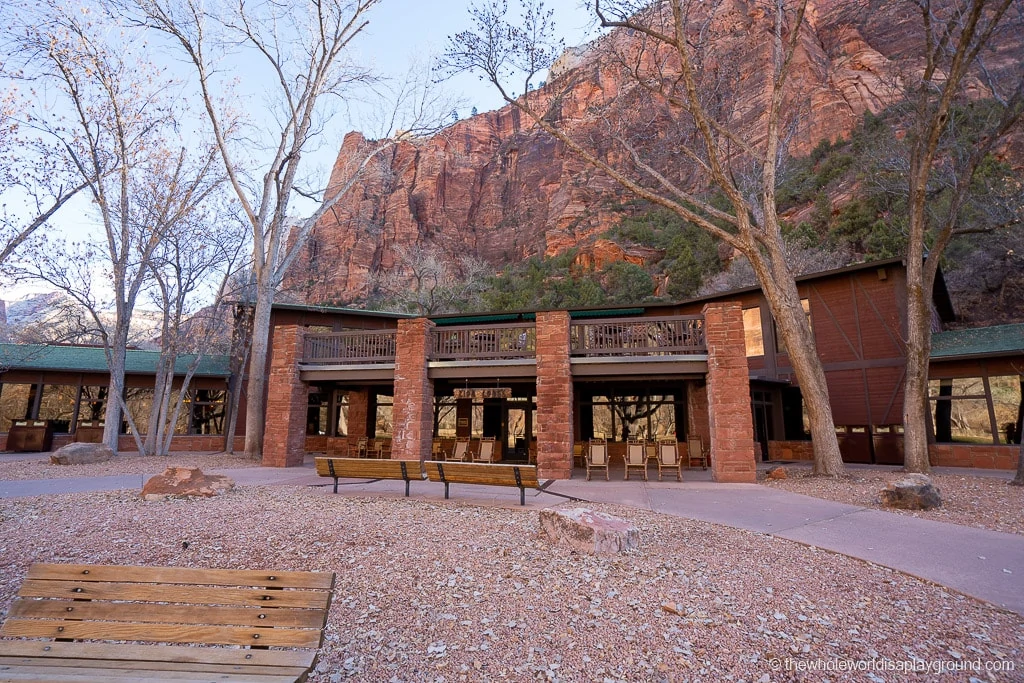
Things to do in Zion National Park
Hiking is the most popular activity in the park and Zion’s hikes are an equal mix of easy, moderate and challenging. Rock climbing and canyoneering are also popular along with a scenic drive through the park.
- Hiking: Zion is home to some incredible hikes and there are a variety of trails suitable for every level of hiker. Some of the best hikes in Zion include the magnificent water-based Narrows, the adrenaline inducing Angels Landing and Canyon Overlook with its incredible views. Riverside Walk and Pa’rus are two great family friendly options and Scout Lookout is the perfect option for those seeking the views from Angels Landing without the terrifying final ascent!
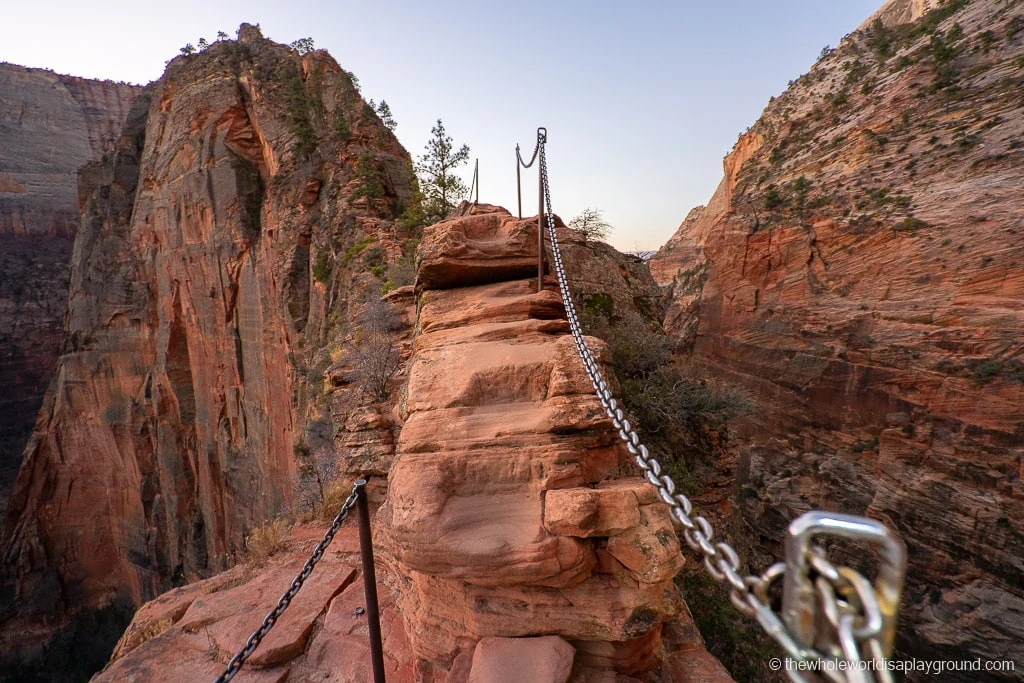
Our other favorite things to do in Zion include:
- Swimming: both the Watchman and Pa’rus trails have access to some great swimming spots and Riverside Walk runs along the Virgin River for those who want to dip their toes in the water. If you are feeling more adventurous Zion Adventures rents tubes for river tubing outside the park.
Ultimate Guide to Zion tip: always check the latest conditions in Zion to ensure safety in the park. For example, in August 2020 toxins from harmful algal bloom were recorded in the North Fork of the Virgin River – during these times visitors are not permitted to swim or submerge their heads in the river and dogs kept away from the river for safety.
- Scenic Drive: The Zion Mount Carmel Highway is a 10 mile scenic drive over bridges and switchbacks and through the Zion Mount Carmel tunnel which cut through the deep stone mountains.
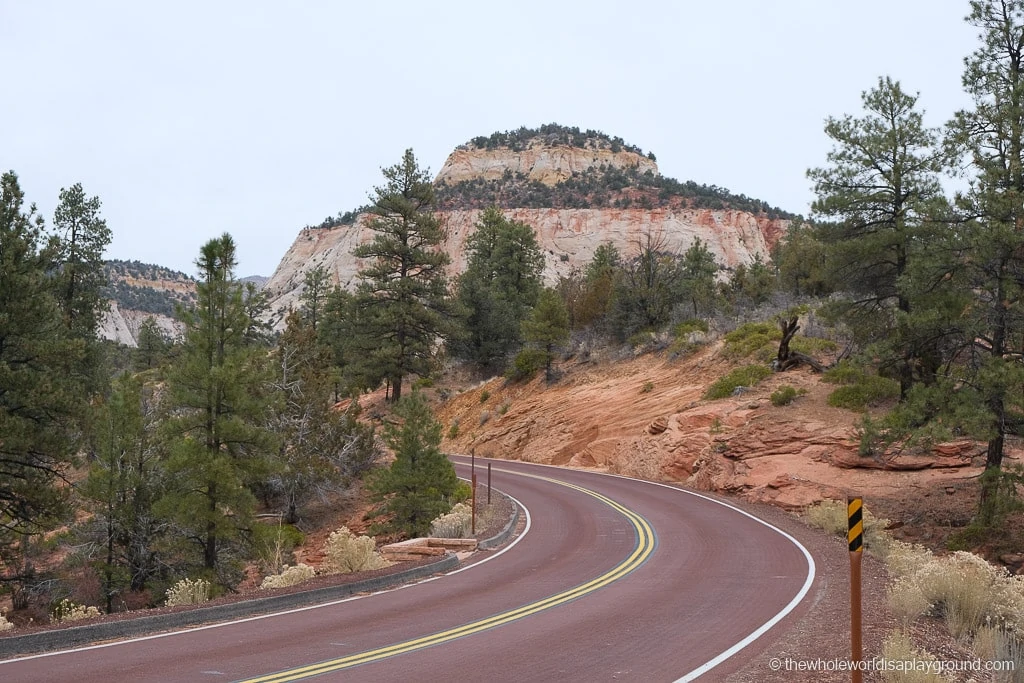
- Indoor fun: the Zion Nature Center, the Visitors Center and the Human History Museum have interesting exhibits which are great for learning more about the park.
- Rock Climbing: it’s no surprise that Zion’s towering canyon walls are a magnet for rock climbers. There are lots of grade IV and grave V climbs. Moonlight Buttress, Ashstar Command and The Headache are among the most popular climbing routes.
- Canyoneering: permits are required for all technical canyoneering trips in Zion. This includes the Subway, Orderville Canyon, Mystery Canyon and Pine Creek.
Navigating Zion National Park
Zion is a little complicated with its separate canyons, multiple entrances and shuttle bus restrictions. It can be confusing when preparing for a first time visitor so we’ve explained below how access to Zion works:
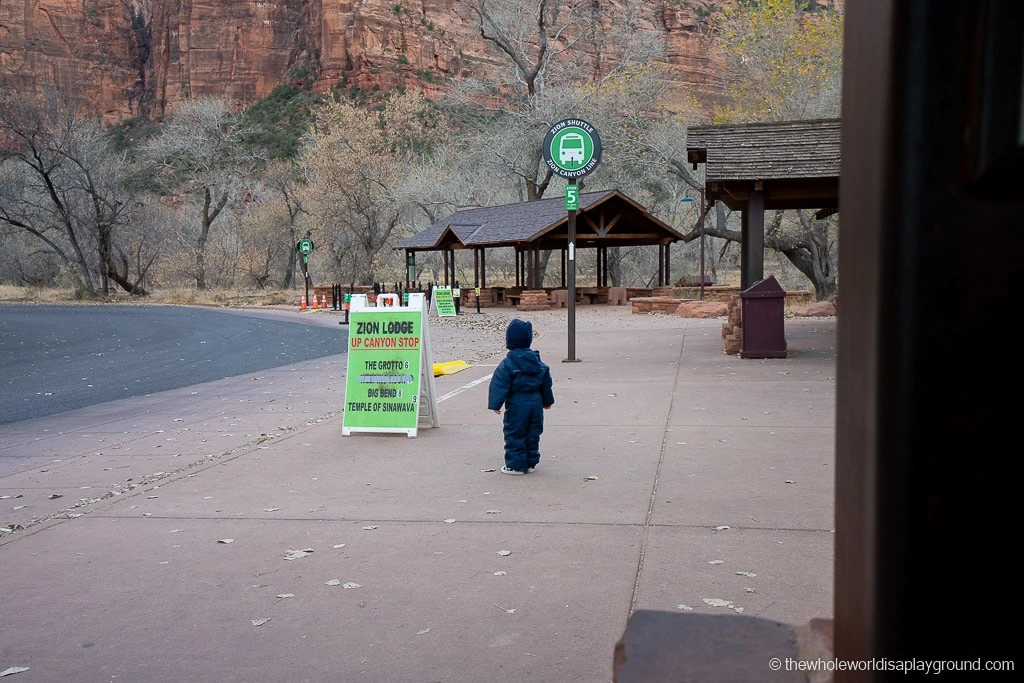
Park Entrances
Visitors enter the main section of Zion via two entrances:
- South Entrance: the South entrance is located beside the town of Springdale. Most visitors to Zion stay in Springdale and will enter the park by the South Entrance. For much of the year, a shuttle bus runs from Springdale to bring visitors into the park. A second shuttle operates from the visitors center and transports visitors to the various trail heads. The shuttle bus system is explained in more detail further down.
- East Entrance: visitors arriving from or departing for areas north of Zion will use the East Entrance. The East entrance is the quickest route to Bryce Canyon and can be incorporated into the drive to Salt Lake City.
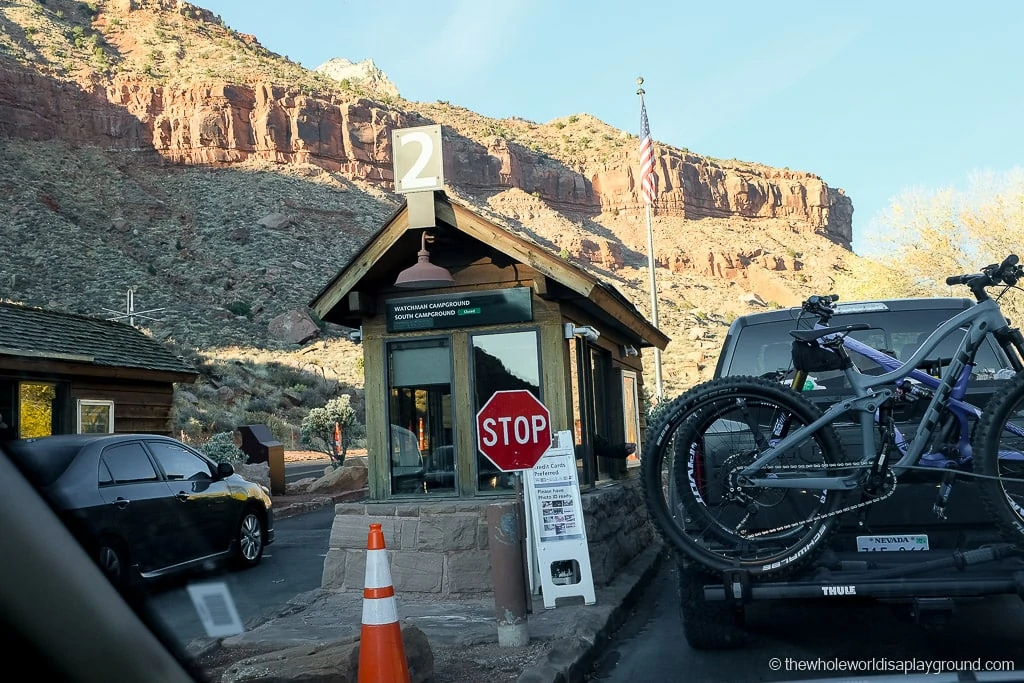
Ultimate Guide to Zion tip: The Zion – Mt Carmel Highway is a scenic drive which cuts through Zion National Park and connects the east and south entrances. It showcases some of the park’s most beautiful scenery including the six switchbacks leading out of Zion Canyon, Checkerboard Mesa, the Zion – Mt Carmel Tunnel and the Canyon Overlook trail. Like many visitors, we drove the highway as we left Zion for Bryce Canyon National Park. We recommend taking scenic drive along the Zion – Mt Carmel Highway regardless of which entrance you are using!
- Kolob Canyon: The Kolob Canyon section of Zion, in the North West of the Park, is accessed by a separate entrance which is about a 40 minute drive north west of Springdale. It is much less visited than the Zion Canyon section of the park. Hikes include the Kolob Canyons Wilderness Trails and access to the permit only Subway is from this section of the park.
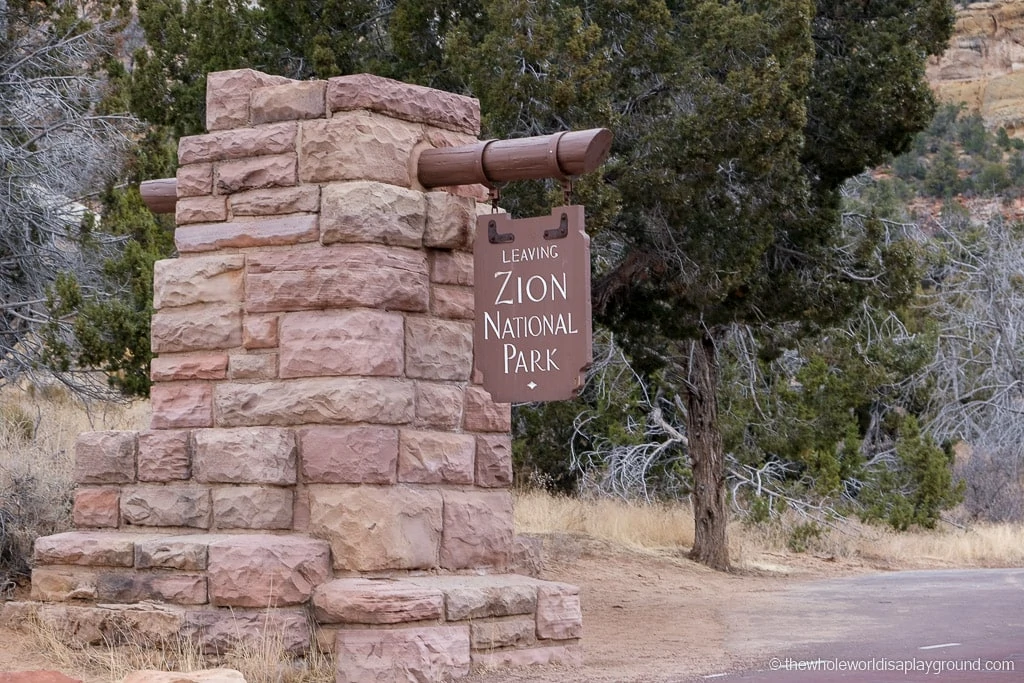
How to use the Zion Shuttle Buses
Two shuttles operate in Zion: the Springdale Shuttle and the Zion Shuttle and, unless you visit the park at its quietest times, it is likely you will use the park’s shuttle service. On most days, access to the Zion Canyon Scenic drive is restricted to shuttle bus only. Many visitors to Zion will also use the Springdale Shuttle as parking in the park is limited and it is often easier to hop on Springdale Shuttle instead.
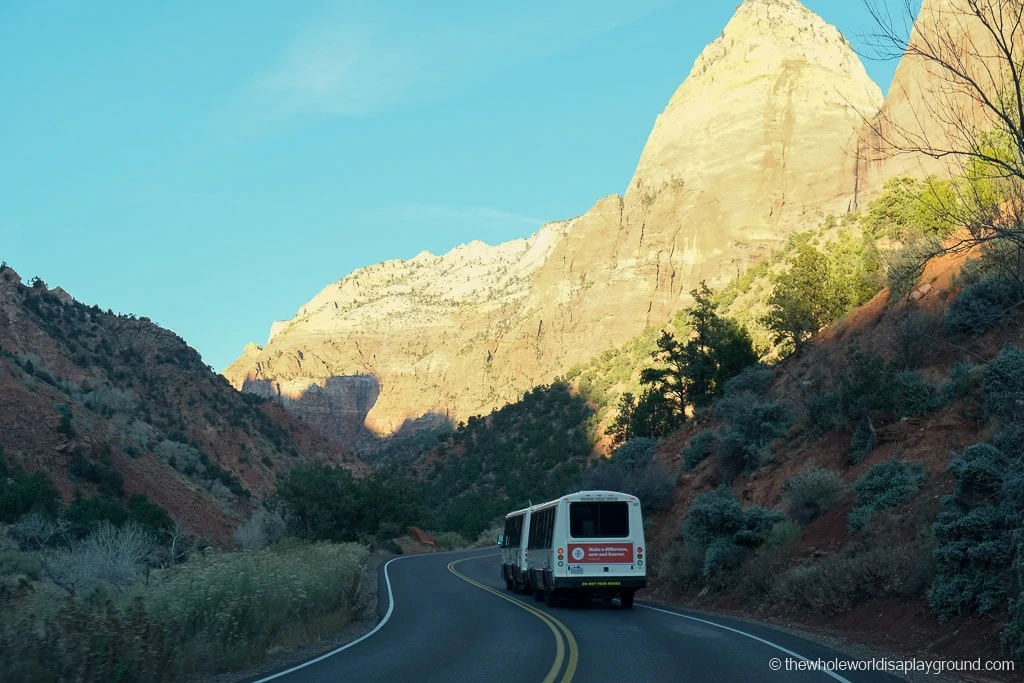
The Springdale Shuttle
Most visitors to Zion stay in Springdale, a small town beside Zion National Park. A second free shuttle, the Springdale Shuttle, services 9 stops throughout the town. It connects with the Zion Canyon Shuttle at the Visitors Center.
The Zion Shuttle
Most of Zion’s hikes are accessible from the Zion Canyon Scenic Drive, a road which runs through the valley floor of Zion Canyon.
A free shuttle bus service operates along the Zion Scenic Drive, stopping at nine locations close to various trails. The route begins at the Zion Visitors Center and terminates at the Temple of Sinawava where the Narrows and Riverside Trails are accessed. Buses are frequent and run every few minutes.
Ultimate Guide to Zion tip: The Zion shuttle bus operates for most of the year although service is generally suspended at off peak times such as weekdays in January. When the shuttle bus is in operation private vehicles are not allowed on the Zion Canyon Scenic Drive.
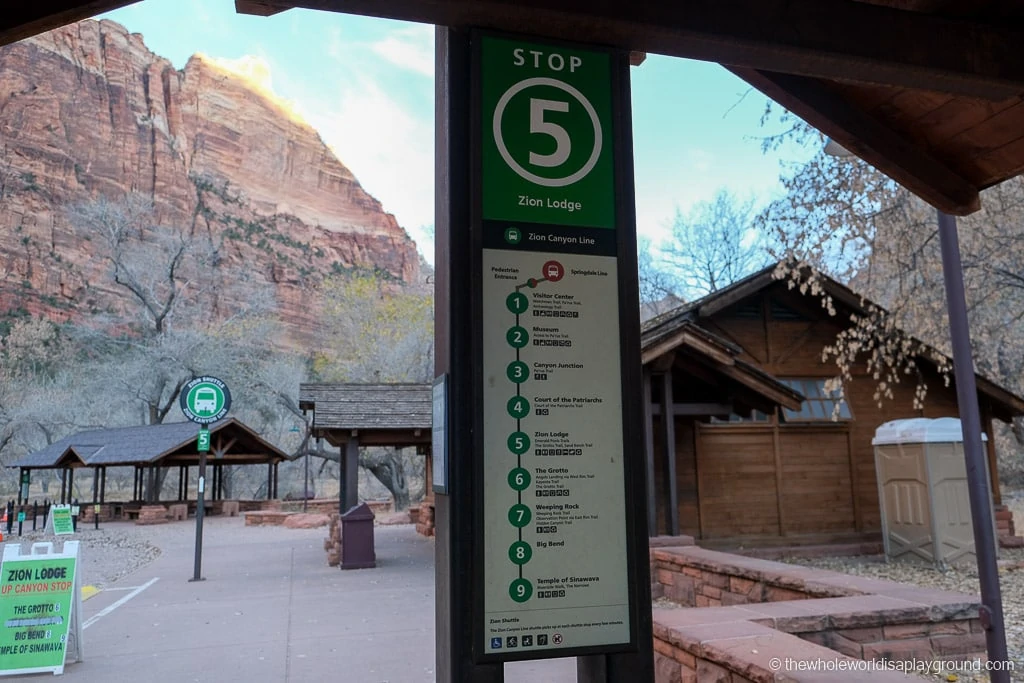
Zion Shuttle Bus Stops
- Stop 1 – Zion Canyon Visitor Center: access to the Zion Canyon Visitor Center, the Pa’rus, Archaeology and Watchman trails and the parks South and Watchman Campground
- Stop 2 – Zion Human History Museum: access to the Zion Human History Museum and some amazing views including the Altar of Sacrifice
- Stop 3 – Canyon Junction: one of the most popular photography spots in the park. Canyon Junction Bridge spans the Virgin River with the Watchman towering in the distance. Stop 3 is also the end of the Pa’rus Trail.
- Stop 4 – Court of the Patriarchs: views of Court of the Patriarchs
- Stop 5 – Zion Lodge: restrooms, food and gift shop at Zion Lodge (note: if you are staying at the Lodge you will receive a special permit to allow you to drive directly to the Lodge), Emerald Pools trail head (currently closed, Upper Emerald Pools accessible via Kayenta Trail at stop 6), Grotto trail (connects Zion Lodge and The Grotto shuttle stops), Sand Bench Trail
- Stop 6 – The Grotto: access to Angels Landing, Scout Lookout, West Rim trail and Kayenta Trail
- Stop 7 – Weeping Rock: Weeping Rock, Observation Point via East Rim trail, Hidden Canyon and East Rim trail. The Weeping Rock stop is currently closed due to a huge rockfall closing the trails.
- Stop 8 – Big Bend: views of Angels Landing
- Stop 9 – Temple of Sinawava: Riverside Walk and the Narrows (the Narrows is accessed at the end of the Riverside Walk trail)
When the shuttle is in operation, parking options include:
- Zion National Park: parking is very limited within Zion and the spaces fill up very early in the day. Parking is available at the Visitors Center and the museum. There are a few spots at Canyon Junction and close to the South Campground.
- Zion Lodge: guests of Zion Lodge are provided with a permit which allows them to drive further into the park to where the lodge is located. The Lodge has its own shuttle stop.
- Springdale: parking is available in the town of Springdale
Ultimate guide to Zion tip: the buses are wheelchair accessible. Strollers must be collapsed at all times.
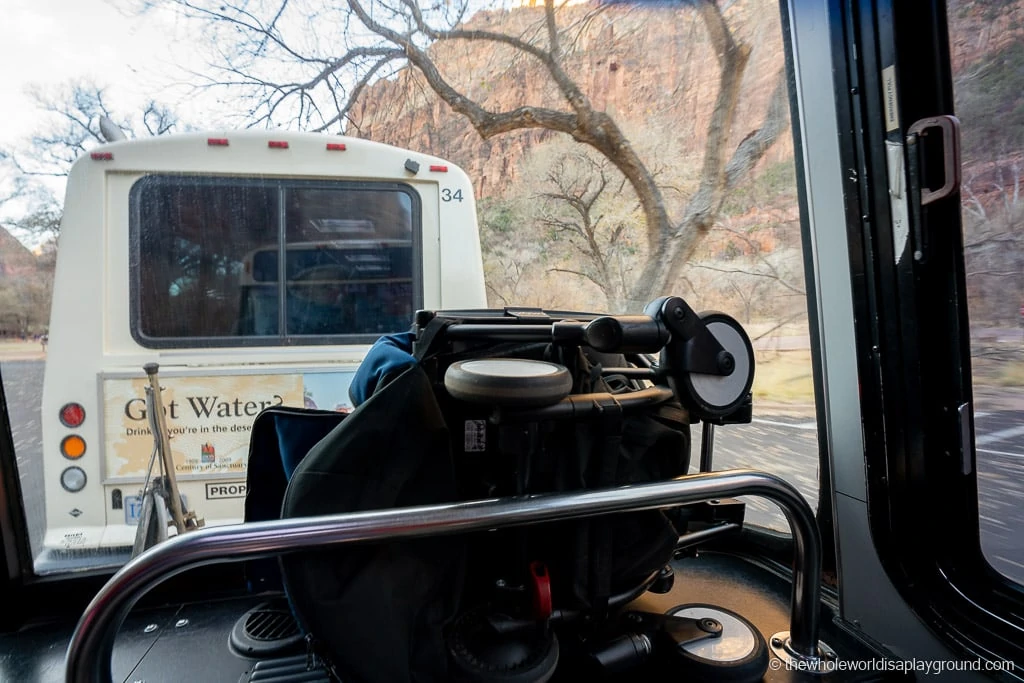
Driving in Zion
There are some parts of Zion that are only accessible by driving. These include:
- Canyon Overlook Trail
- Zion – Mt Carmel Highway and the Zion – Mt Carmel tunnel
- Kolob Canyons Section
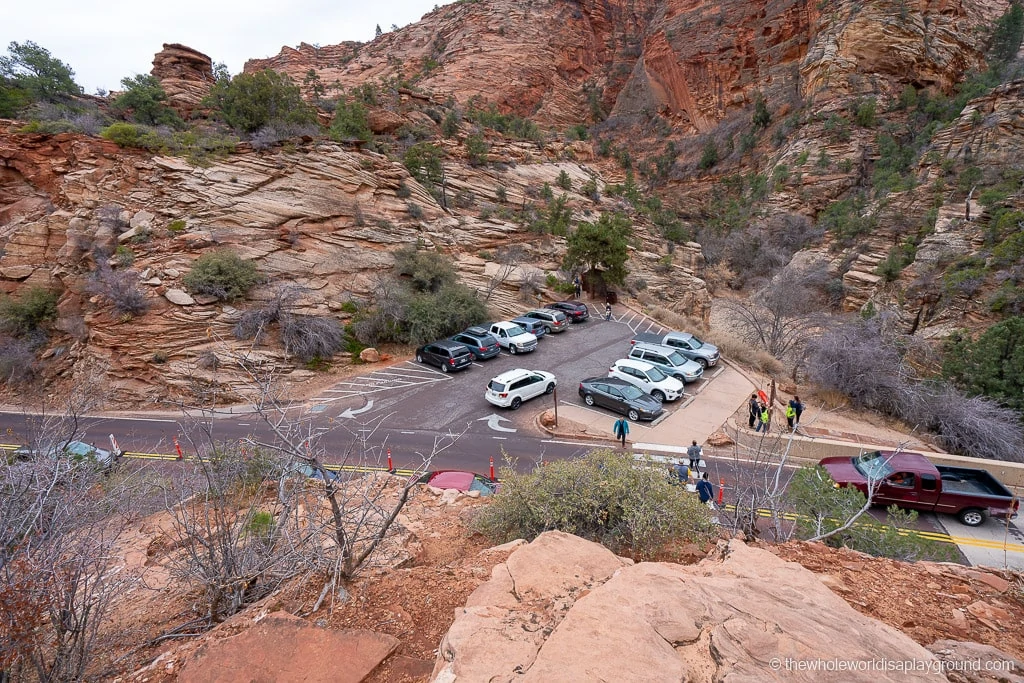
Driving is sometimes permitted in Zion:
- Off peak access to the Zion Canyon Scenic Drive (only when the shuttle is not running): During off peak times in the park the Zion Shuttle is suspended. Visitors are permitted to drive along the Zion Canyon Scenic Drive and park at the various trail heads/shuttle stops. Visitors must only use allocated spaces. It is important to arrive early as, when capacity is reached, the Scenic Drive is closed to any further vehicles.
- Zion Lodge: guests of Zion Lodge are provided with a permit which allows them to drive further into the park to where the lodge is located. The Lodge has its own shuttle stop.
- Between the South Entrance and Canyon Junction: private vehicles are permitted on the stretch of road between the South Entrance and Canyon Junction. At the junction, the road continues to the Zion – Mt Carmel Highway or turns off to the Zion Canyon Scenic Drive.
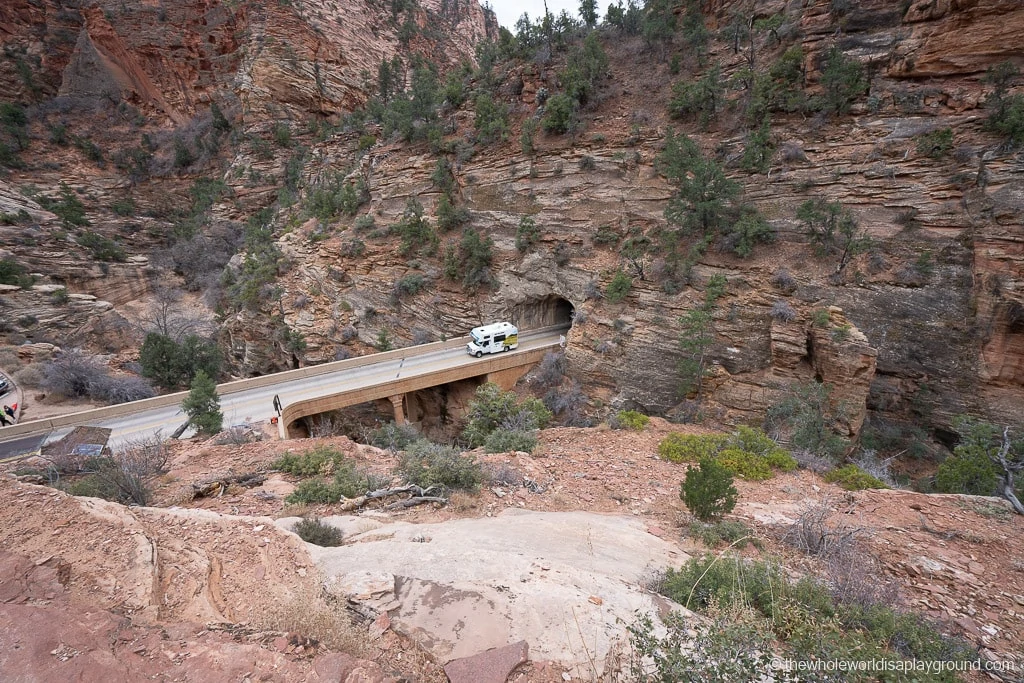
Cycling in Zion
Cycling is an awesome way to explore Zion. It avoids queues for the shuttle and allows visitors to come and go at their own pace. It is possible to cycle from Springdale to the Zion Canyon Scenic Drive.
- Bikes are allowed on all roads in the park and are permitted on the Zion Canyon Scenic Drive. Cyclists must pull over to allow shuttle buses to pass on the Scenic Drive.
- Hop on the Zion shuttle if you get tired – the shuttles have bike racks which fit a couple of bikes. Many cyclists take the shuttle to the Temple of Sinawava at the end of the canyon – the cycle back towards the Visitors Center is downhill.
- The Pa’rus trail is the only bike friendly trail in Zion.
How long to spend in Zion National Park
For first time visitors we recommend spending at least 2 full days exploring Zion National Park. This allows the time to attempt a nice variety of hikes, enjoy the scenic drive through the park and have some downtime just savoring the spectacular and dramatic surroundings.
If you have one day in Zion
These hikes showcase some of the best features of Zion National Park and are a great introduction to its trails
- Riverside Walk: a leisurely stroll along the Virgin River. The Narrows begins at the end of Riverside Walk so take the opportunity to check out a small portion of the trial (2 hours)
- Scout Lookout: follow the West Rim trail from the Grotto to Scout Lookout for spectacular vies of Zion Canyon below and Angels Landing up ahead. (2 hours)
- Canyon Overlook: for spectacular views over Zion Canyon (1 hour). Canyon Overlook is on the east side of the park and the drive over is beautiful: it passes through a series of switchbacks before reaching the Zion – Mt Carmel Tunnel. Continue on a little further past the Canyon Overlook trail head and make a stop at Checkerboard Mesa, a rock with a unique criss cross pattern.
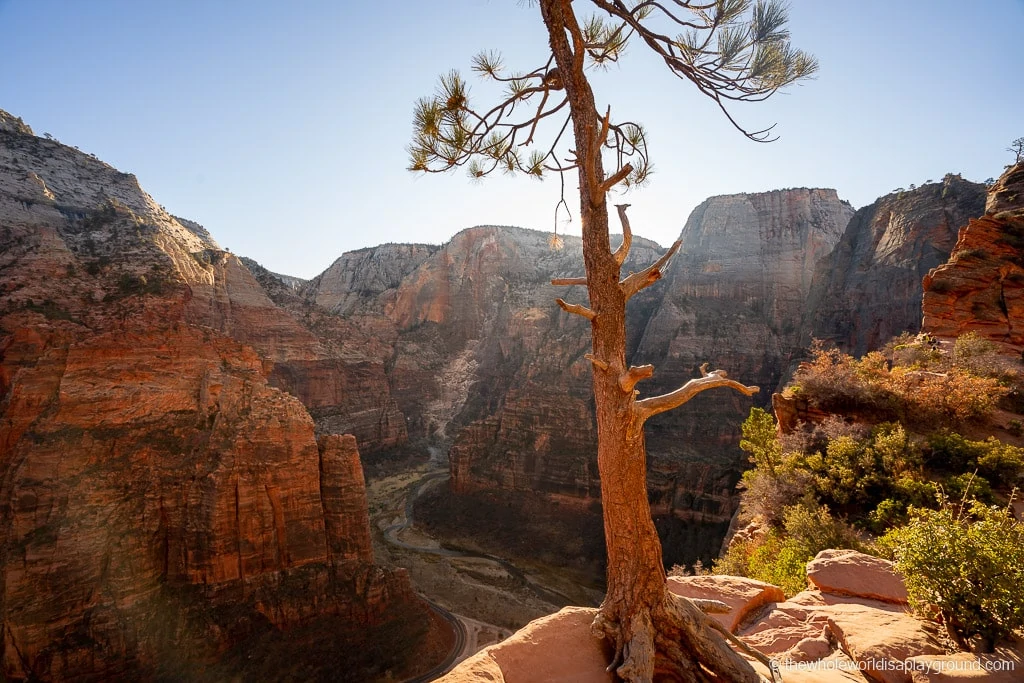
If you have two days in Zion
Two days will allow time to include the Narrows and Angels Landing, two classic Zion trails.
- Angels Landing: take a sunrise hike to the iconic Angels Landing, one of the most challenging trails in Zion (5 hours). If you plan to hike Angels Landing then you don’t need to include Scout Lookout as a separate hike. Angels Landing follows the same trail as far as Scout Lookout before branching off to Angels Landing.
Ultimate Guide to Zion tip: Note that permits are required for Angels Landing for visits after 1 April 2022. The permit requirement only applies to the portion of the trail from Scout Lookout to Angels Landing. It is still possible to hike to Scout Lookout without a permit.
- The Narrows: dedicate the afternoon of your first day to hiking the Narrows, a classic Zion water-based trail along the Virgin River and into a narrow canyon (6 hours to Wall Street and back)
- Kolob Canyons: if you have time, make the 40 minute drive over to Kolob Canyon and hike one of its Wilderness trails. Our favorite is Timber Creek Overlook, a 1 hour trail with spectacular views over the valley.
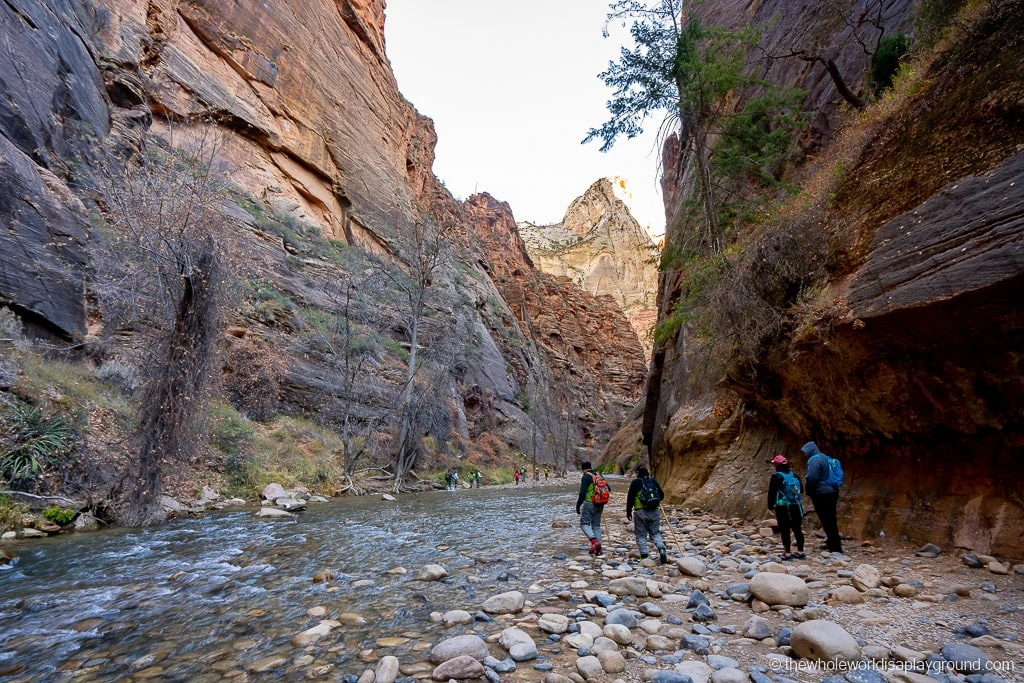
Best time to visit Zion
Zion is an excellent year-round destination with most of the trails remaining accessible throughout the winter months:
- Spring: Spring is a great time to visit Zion. Temperatures are on the rise and the early wildflowers begin to bloom making it a beautiful time in the park. On the downside, the Narrows is often closed as a result of melting snow increasing the river flow and some high elevation parks of the park may be closed due to lingering snow.
- Summer: temperatures often exceed 100°F in summer and, with many trails exposed to the sun, hikes can be challenging in the middle of the day. Visitor numbers peak in summer so expect crowded trails and a wait for shuttles. Flash floods are also a risk in summer.
- Fall: Fall foliage and mild temperatures make this a great time of year to visit Zion.
- Winter: Zion National Park in Winter is often a place of solitude and beauty with less visitors resulting in quieter trails and less expensive accommodation. Although winters tend to be relatively mild, the trade-off is cooler temperatures and the prospect of weather-related trail closures.
Ultimate Guide to Zion tip: the more moderate weather conditions make Spring and Fall the most desirable time to visit the park. We visited Zion in Winter 2019 and loved the quietness of the park
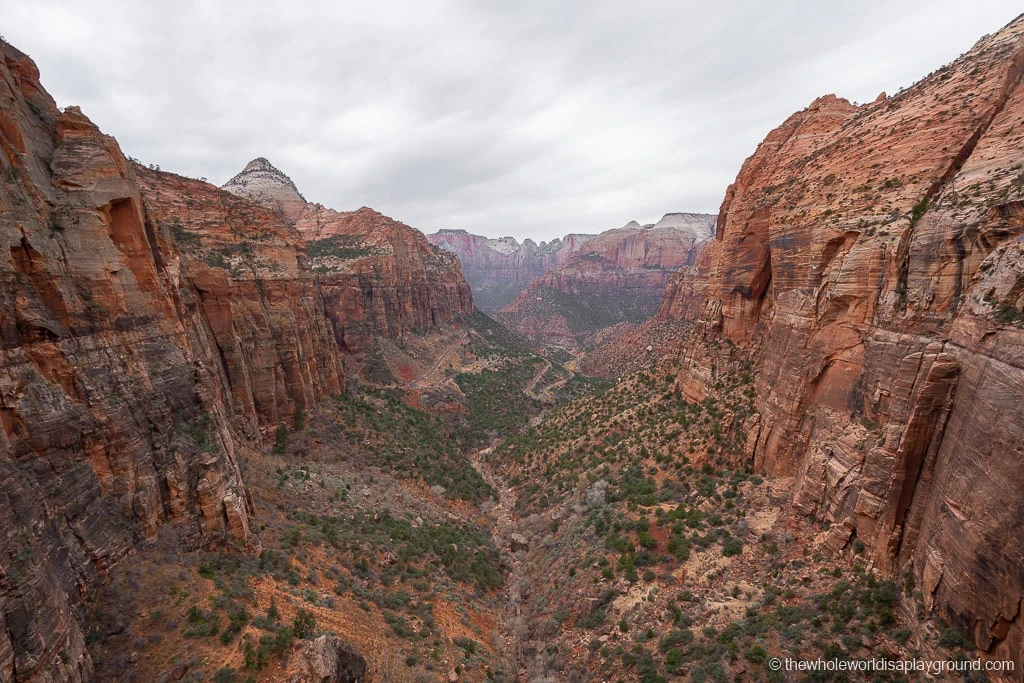
Tips for visiting Zion National Park
- Trail closures: rockfall and trail maintenance has led to trail closures including Weeping Rock, Hidden Canyon, the Lower Emerald Pool and Observation Point via the East Rim. The Narrows is dependent on water flow and closes when the water flow exceeds 150 cubic feet per second or if there is a risk of flash floods.
Ultimate guide to Zion tip: Check the trail status on the official Zion website or at the Visitors Center for latest information.
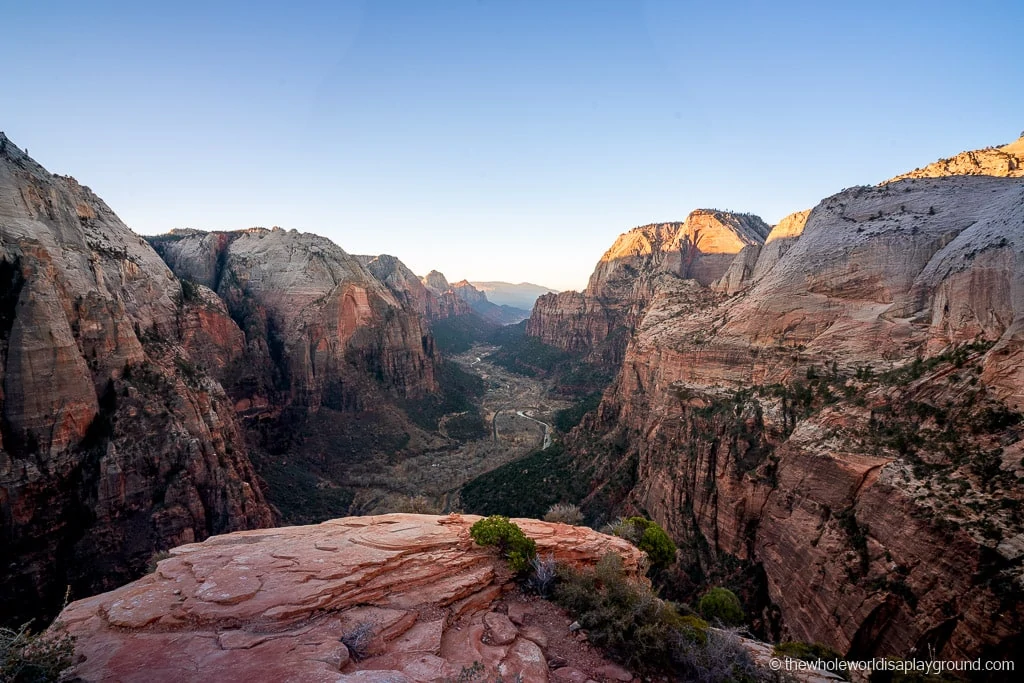
- Arrive early: The park gets extremely busy so the earlier the better! We start our mornings at sunrise and it is incredible to enjoy the park at a quieter time. Early arrivals might also secure one of the limited parking spaces within the park which means you avoid having to use two shuttles.
Ultimate guide to Zion tip: if you are planning on hiking the iconic Angels Landing it is best to catch the first shuttle into the park. Angels Landing attracts crowds from the first shuttle but it gets much busier later in the day.
- Snacks and Water: there are water filling stations throughout the park. They can be found at the Visitors Center, Zion Lodge, the Museum and at the Grotto and Temple of Sinawava shuttle stops.
- Winter hikes:the trails can be very icy in the winter. It is essential to wear shoes with a strong grip or pick up some Yaktrax for your sneakers. Layer up and stay well wrapped up from the cold. Remember to add some extra layers for kids in carriers as they’re not running around and can get very cold.
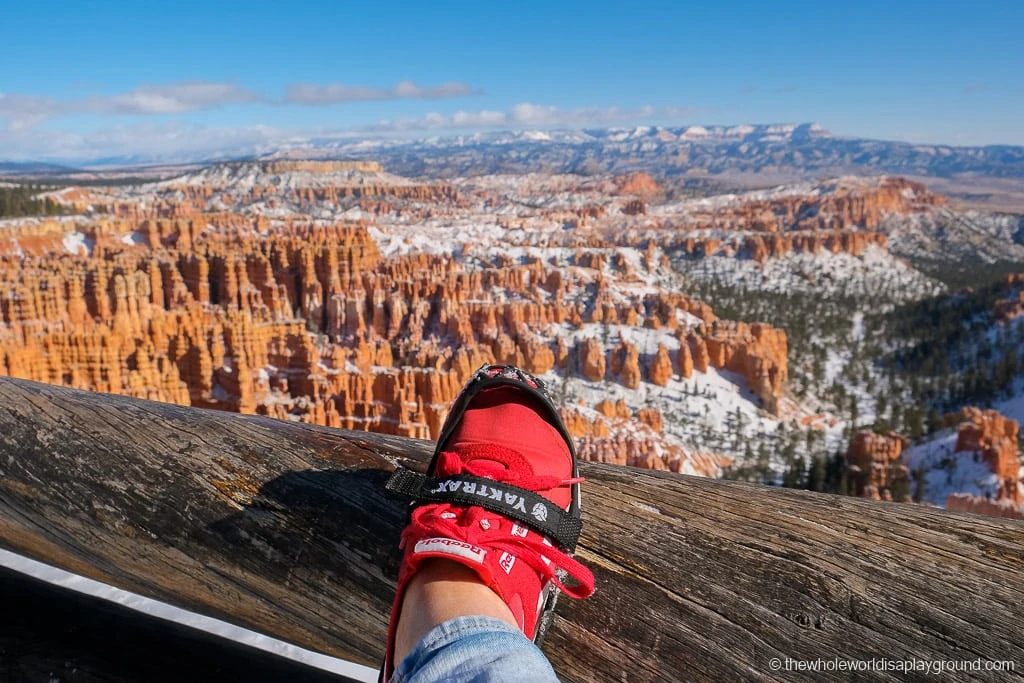
- Summer hikes: summer temperatures can be extreme so it is a good idea to hike outside the peak sunshine hours. Bring lots of water, sunscreen and sun hats.
- Entrance fees: weekly passes allow entry for 7 consecutive days. They cost $35 for private vehicles, $30 for motorcycles and $20 per person for those walking or on bikes.
- Multiple Parks: if you are planning on visiting multiple parks make sure to purchase an America the Beautiful National Parks Pass. They cost $80 and cover entry for the pass owner and other passengers in the vehicle. We saved a ton of money by purchasing a pass at the entrance of the first National Park we visited.
Disclaimer: As an Amazon Associate I earn from qualifying purchases.
